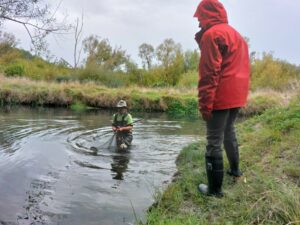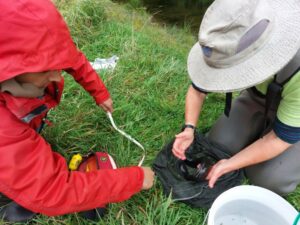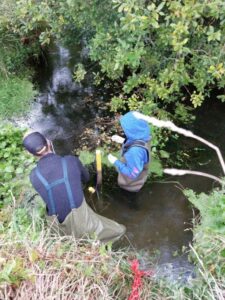Ecological data captured by Year 13 Lincoln High School students during a field trip to Tārerekautuku Yarrs Lagoon will be used by Selwyn District Council and others to guide future management of the site.
The group of year 13 ecology students braved a raging southerly to take part in a pioneering monitoring programme, alongside Environment Canterbury staff and experts from Department of Conservation (DOC) and Lincoln University.
This pilot developed in partnership with Enviroschools provides experiences and technical support for real-life science that aligns with NCEA assessment requirements. It’s inspired by the school’s Head of Science Willem Tolhoek’s ‘vision’ for students to experience real science beyond the confines of the school laboratory.
“It’s important that we apply what students learn in the classroom, by connecting them with experiences within their local community. In this instance, students could hone their skills and knowledge alongside those who’ve transferred their passion for science into a career.” Willem Tolhoek, Lincoln High School, Head of Science
It is hoped the pilot will eventually be adopted as a means of formal assessment as part of the school’s localised curriculum.
About Tārerekautuku Yarrs Lagoon
Tārerekautuku Yarrs Lagoon is one of the largest freshwater wetland habitats remaining in the low plains of the Selwyn District. It is located near the Lincoln township in the Ararira/LII River sub-catchment of Te Waihora/Lake Ellesmere and was once an important mahinga kai (food gathering) site for Ngāi Tahu.
Despite modification, it still has significant ecological and cultural significance and is an ideal place to learn about local ecosystems and monitor their health. Read more about the Tārerekautuku Yarrs Lagoon.
Hands-on science
Based on their interests, the cold but keen ecology students were put into groups and supported to build knowledge and skills around specific monitoring tasks and complete these.
These included:
Pest monitoring
DOC rangers, Craig Alexander and David Thomas, helped students set up tracking tunnels, chew cards and a camera to monitor for pests such as possums and stoats.
Freshwater macroinvertebrate monitoring
Macroinvertebrates are the small organisms found in waterways and include a variety of fly larvae, beetles, worms and snails. They are an excellent indicator of stream health as they can be impacted by organic pollution.
Freshwater ecologists, Annabel Barnden and Siobhán Culhane, supported the students as they developed a freshwater macroinvertebrate monitoring regime to assess water quality.
This involved ‘kick sampling’ with a net (standing in the stream and literally kicking sand and stones to dislodge macroinvertebrates) and ‘sweeping’ the sides of the stream where there is overhanging vegetation. The macroinvertebrates were then identified and released back into the waterway (see banner image: identification and counting of macroinvertebrates).
Lizard monitoring
Lincoln University herpetologist Jennifer Gillette led the monitoring of lizard populations. Her group laid out tracking tunnels using tinned pears as bait and left them for a week.
Fish monitoring
Freshwater ecologist Helen McCaughan set fish traps the night before the students’ visit, using a protocol that had been previously discussed with the students in class. It meant the group could get up close with native fish and learn how to identify them and record measurements of them and their habitat in a scientific way. Species caught included īnanga/īnaka (whitebait), common bully and both species of tuna/eels – including some tuna nearly one metre long.

Retrieving the fish trap.

Freshwater ecologist Helen McCaughan and a student record the length of a tuna/longfin eel.
Vegetation monitoring
Biodiversity advisor Will Todhunter took a group into the dense undergrowth to complete a vegetation monitoring plot. This involved marking a 10m x 10m square in the wetland and identifying all the plants within it.
eDNA sampling
In a first for the site, Willem Tolhoek led a group to take environmental DNA (eDNA) samples from the watercourse. This involved using a large syringe to hand-filter water from the stream through an eDNA filter.

Collecting an eDNA sample for analysis by Wilderlabs.

Year 13 student, Emma Wheeler, looks closely at the fins and colouration to determine which Gobiomorphus (Bully) species they have sampled to record in the NZ Freshwater Fish Database.
Analysis of these samples will reveal any plant and animal species that have been in and around the water area. Past eDNA monitoring experiences have resulted in some surprising discoveries, including species thought locally extinct. In a similar sample on the Pūharakekenui/Styx River, eDNA evidence of a long-tailed bat was found.
View the analysis of the Tārerekautuku Yarrs Lagoon eDNA sample.
Diving into the data
Now the soggy data has dried out, students will begin analysing their findings. Their data sets will build on a Baseline Assessment taken by Lincoln University students in 2022.
Enviroschools facilitator Matt Stanford enjoyed seeing the next generation of scientists working alongside established professionals.
“We’re all looking forward to seeing how their data sets compare with the baseline data taken in 2022. The methodology of that study informed how this year’s data was collected, to allow for direct comparison. For example, in-the-field analysis revealed stick cased caddisfly larvae at a site where none were sampled in 2022. The discovery of this more sensitive species could indicate an improvement in water quality – but we’ll have to wait and see how the students interpret the data set,” Matt said.
Year 13 student, Farah Aladem, said she found the trip extremely beneficial.
“Not only did I gain hands-on practical skills that I could put into my future studies, it allowed me to learn more about scientific methods – and to explore the concept of eDNA. We were able to look at scientific practices beyond the classroom environment, and what NCEA teaches us. We also linked the skills that we got out of our first internal (practical investigation) to what we were meant to do on the trip. I’m very grateful that we were given this opportunity.” – Farah Aladen, ecology student
Planning for the lagoon’s future
The data will also be used by Selwyn District Council staff as they implement their Draft Reserve Management Plan, which will become the guiding document for the future management of Tārerekautuku Yarrs Lagoon.
Selwyn District Council biodiversity officer Denise Ford said the Council is thrilled to see the site being used as a living laboratory by Lincoln High School.
“The information the students collect will help build up a picture of the ecology of the wetland, and add to the baseline data. Comparisons can be made over time that will show us how and if our interventions (weed control, planting and pest management) are making a difference. We thank the experts who so generously gave their time and knowledge on the day, and we’re looking forward to working with the school in the future.” – Denise Ford, Biodiversity Officer
The trip was funded through the Tait Foundation, which supports STEM subject (science, technology, engineering and mathematics) initiatives with a focus on students in Canterbury.
We are gratefully to Environment Canterbury whose article Year 13 students embrace in-the-field learning | Environment Canterbury (ecan.govt.nz) this story was based on. We would also like to acknowledge Lincoln High School for the inspiration, all those who provided their expertise and Enviroschools Waitaha for their on-going commitment to the kaupapa.
November 2024 Update:
This report is a result of a collaboration between the Selwyn District Council, Lincoln University, Lincoln High School and Enviroschools. The idea for students to visit and undertake some environmental monitoring at Tārerekautuku Yarrs Lagoon was based of an idea from Mike Bowie who completed a similar, but more comprehensive project alongside Post-Graduate Students from Lincoln University in 2022. The aim of this report is to present a small snapshot of data collected on this trip. The trip in itself also acted as a template for future trips which we hope will be expanded into the future.
2024_Canterbury_Lincoln High School_Restoration Monitoring at Tārerekautuku Yarrs Lagoon Reports